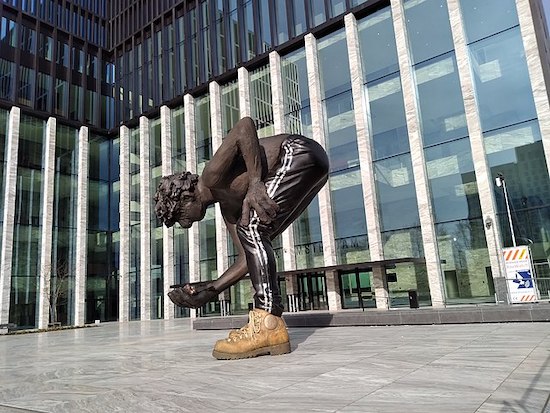Love or generosity (2020) bij de Rechtbank van Amsterdam, Parnassusweg. Photo: Ceescamel. CC BY-SA 4.0
Nicole Eisenman’s new sculpture, Love or Generosity, has just been installed outside the New Amsterdam Courthouse. Gender-fluid, and featureless save for a bulbous nose, with mussed hair and chubby hands, the figure is recognisable from the other over-sized figures of her recent oeuvre. And, like much of Eisenman’s work, Love or Generosity is funny; the figure’s posture is deliberately ungainly, knees bent in a half squat, bum in the air, a little extra flesh pressing over the waistband of its adidas tracksuit bottoms, elements that are comically at odds with the gleaming marble floor of the forecourt and the building’s severe contemporary architecture. A humorous subversion of its immaculate surroundings, the figure seems to offer a glimpse of genuinely utopian possibilities.
Taller than her other figures, this one is a real giant, about five metres high, and it seems taller because of the implied height of its bent posture – at full height it would be twice that size. The formal choice of the bent posture is ingenious, and allows the figure to serve as an intermediary between the large scale of the ten-storey courthouse and the much smaller, human scale. The height of the building is gestured to in the giant’s latent height, while its attention, and therefore ours, is directed to its palm, which, full of intriguing objects, is at our eye level. The sculpture is aptly named: it does feel generous – helping to integrate the rather austere building into its environment, and humanising the architecture with its genial scruffiness. Meanwhile, the giant’s mediation between the building and the human figure acknowledges and makes room for the human scale, which is so often overwhelmed in such contexts.
In Eisenman’s earlier sculptural work, the comic contrast is instead with the dignity and perfection of classical statuary, her installation at the Carnegie Museum of Art in 2013, for example, where the figures interact with the collection of Greek and Roman casts, and Fountain (2017), where the group of scruffy figures lounging around a pool contrasts with the classical model of the fountain as a composed and idealised public centrepiece. In Love or Generosity the classical exemplar may not be as present, but as a piece of public art the expectations of virtuosity remain, and both the loose modelling of the figure and its general lack of decorum (the semi-squat, its naked top half, the leisure wear) contrasts with the formality of the public space. While her previous giants were unclothed, the decision here to opt for tracksuit bottoms may well have been partly pragmatic – to avoid any fixation on the genitalia (or lack thereof) that would otherwise occupy a central position – but the figure’s half-clothed state still creates the feeling of comfort and ease that is so evident in her other, unselfconsciously naked figures.
Eisenman clearly thinks of her giants as having a real presence in the world: holders of palpable energy, with the potential to change an atmosphere; and she’s talked about sculpture’s capacity to work ‘below the neck’, working viscerally to prompt involuntary, instinctual reactions. She describes the figures fondly as the “scruffy, bohemian great-great-grandchildren of [Greco-Roman] gods”. And she is explicit about their undercutting of classical ideals: the original forms are “all athletic and gorgeous and smooth and white’, which ‘seems like something that needs to be taken down a notch”. This new generation is a utopian one, contentedly imperfect, free from the disciplining of gender and social decorum (hairy legs, pot bellies, postures heedless of propriety), free also from the imperative for productivity that is so central to the neo-liberal ethos. They model instead an alternative, more spacious way of life, where daydreaming and contemplation are prized.
It’s probably just a consequence of their scale, and their difference (those enormous noses), but the figures’ obliviousness to social norms feels so complete as to be radical: it is quite literally obliviousness on a grand scale. Their indifference to social convention seems comic to us, partly because such obliviousness provides a form of vicarious relief from the exhausting work of social compliance. Conformity requires ceaseless adaptation and self-policing, and witnessing and sympathetically participating in the disregard of that process is both freeing and funny.
Love or Generosity doesn’t stop there though, because the figure is also making us an offering: the owl, arrow, and acorn cupped in its hand. It’s worth noting that, for all the merits of the figure in its own right, it is also a radical, maximalist re-interpretation of the traditional plinth, the sculptures in the giant’s palm given further prominence as its attention guides our own. (This is in itself a classical technique: think of all those Old Masters with the gaze of spectators reinforcing our focus upon a central subject.) The precise meaning of the objects is not entirely clear, and might be partly inspired by Eisenman’s interest in tarot and other esoteric spiritual systems, but we can suggest initial interpretations which all tally with the aspirations of justice; the owl representing wisdom, the arrow perhaps true aim, the acorn potential growth. The idiom of the symbols is cartoonish: the acorn is amusingly chubby, and the owl’s eyes point very slightly in different directions. It’s an offering that is richly symbolic, but not in the least self-serious, and the visual language is entirely without intimidation.


